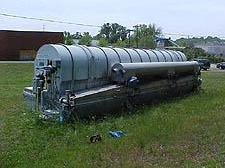Managing Odor & Opacity with Regenerative Thermal Oxidizers (RTOs)
.webp)
See how RTOs can help control odor and opacity
RTOs can help control odor and opacity from "dirty" industrial exhaust air streams.
Regenerative Thermal Oxidizers (RTOs) are designed to destroy volatile organic compounds (VOCs), hazardous air pollutants (HAPs), and odorous emissions from industrial exhaust streams. In addition to reducing harmful pollutants, RTOs play a vital role in controlling opacity (visible emissions) and odor, both of which are critical for regulatory compliance and community impact.
What Is Opacity?
Opacity measures how much emissions obscure visibility—essentially, how "smoky" or visible the exhaust appears. High opacity can indicate incomplete combustion or excessive particulate matter, both of which can lead to regulatory violations.
RTOs help maintain low opacity by ensuring complete combustion of pollutants, resulting in a clean, nearly invisible exhaust stream. Proper system design, tuning, and maintenance are essential to keeping opacity within permitted limits.
Odor Control with RTOs
Odors from industrial processes—such as those in food processing, chemical manufacturing, or coating operations—are often caused by VOCs and other organic compounds.
RTOs are highly effective at eliminating odors, typically achieving destruction efficiencies of 95–99%. By oxidizing these compounds at high temperatures (often above 1,400°F), RTOs convert odorous emissions into harmless byproducts like carbon dioxide and water vapor.
Applications Where Opacity & Odor Control Matter
RTOs are widely used in industries where visible emissions and odors are a concern:
- Foods - Cooking oils and organic compounds
- E-Coating - Paint solvents & VOCs
- Styrene - Used in plastics and composites
- Ethanol - Fermentation and distillation processes
- Graphic Arts & Heat Set Printing - Ink solvents and odorous compounds
- Insulation Manufacturing (Opacity) - Particulate emissions from mineral wool and fiberglass
- Fiberglass - VOCs and visible emissions from resin curing
Key Factors That Influence Opacity & Odor Performance
- VOC Loading: High concentrations may require system adjustments or auxiliary components like hot side bypass dampers.
- Combustion Temperature: Maintaining optimal temperatures ensures complete oxidation and minimal visible emissions.
- Residence Time: Adequate time in the combustion chamber allows for thorough breakdown of pollutants.
- Turbulence: Turbulence is a critical factor in an oxidizer process because it ensures thorough mixing or the oxidizer (like oxygen) with the combustible material (like a volatile organic compound or VOC).
- System Maintenance: Regular cleaning and inspection of burners, media beds, and dampers are essential for consistent performance.
Monitoring & Compliance
Opacity and odor are often regulated by local, state, and federal environmental agencies. Facilities using RTOs must monitor these parameters to ensure compliance, which may include:
- Continuous Opacity Monitoring Systems (COMS)
- Periodic odor sampling and analysis
- Stack testing and emissions reporting
RTOs Maintain Air Quality
Managing opacity and odor with RTOs is essential for maintaining air quality, meeting environmental regulations, and supporting community relations. With proper design, operation, and maintenance, RTOs offer a reliable and efficient solution for controlling both visible and odorous emissions.
FAQs for Managing Odor & Opacity
Get quick answers to commonly asked questions regarding RTOs and their ability to manage opacity and odor.
Yes, in some cases. Visible emissions or opacity, often seen as puffs during poppet transitions, can occur. However, a puff chamber can significantly reduce or eliminate these visible emissions.
Yes, we can assist in evaluating your system to identify issues such as leaking valves, heat exchanger problems, poor airflow distribution, or catalyst performance. We provide thorough assessments and turnkey solutions to help you stay operational. For regenerative thermal oxidizers (RTOs), see our blog post about stack test failures for more troubleshooting guidance.
Yes, if your process stream contains corrosive compounds or halogenated compounds (like chlorine, bromine, or fluorine), the RTO may require special materials of construction such as high-alloy stainless steels or corrosion-resistant coatings to ensure long-term durability and safe operation.
We can evaluate your system by measuring airflow and emissions at key points to assess its current performance. If it’s not optimized, we’ll recommend improvements such as adjusting system settings or adding capture hoods and enclosures. We can also provide these solutions as part of a new system if needed.
Regenerative Thermal Oxidizer Treating Paint Spray Emission
Kono Kogs provided a refurbished, very well built, regenerative thermal oxidizer (RTO) system with expansion capacity of an additional 50% for a client.


